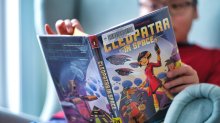Using Comics and Graphic Novels to Support Literacy
Nontraditional books can help students make connections to content at the word level and deepen understanding by providing visual context.
Your content has been saved!
Go to My Saved Content.Let’s look closely at the literacy work that can be done with comics and graphic novels in literacy instruction, particularly with upper elementary and middle grades students. While some strategies helpfully focus on work at the word level, these visual texts afford additional possibilities.
My history with comics began at a young age, but I only remember finding one graphic novel (an adaptation of the Clash of the Titans film) in my school library growing up. Soon after I started teaching middle school, however, graphic novels began to make their way into classrooms. I first remember seeing the work of Raina Telgemeier and Doug TenNapel at library book fairs.
So, are these books merely dessert when it comes to literacy, or are they fruitful texts for instructional purposes?
Encourage Rereading by Choice to Build Fluency
Part of the limitation with many reading support approaches is a focus on a singular area of reading—for example, phonemic awareness or phonics. I contend that there is more than word-level work to be done with reading as students navigate the complex texts that are part of reading and composing life in upper elementary and beyond.
Fluency is about more than timers and speed—there’s also something to be said for multiple exposures to a wide range of texts, and what better way to encourage rereading than by embracing materials that students readily want to read and revisit? I often felt that engagement with a low-interest/low-relevance text once from my students was a gift and investment from them. After all, I don’t readily engage with material I don’t like to read as an adult—even as someone who really loves to read.
Moreover, fluency can be encouraged across multiple content area readings through comics. Comics tackle many topics and content areas, and their inviting nature makes for compelling rereading. Science Comics, published by First Second, visually and verbally presents concepts and vocabulary through the use of picture support, and series like Seen, published by BOOM! Studios, share stories of historical figures through words and pictures.
Adding to Comprehension: The Butterfly Effect
The oft-cited example of how not to use picture support is teaching the word butterfly by pointing to a picture of a butterfly instead of the word itself. I completely agree that teaching vocabulary and new words includes a focus on the individual word and word parts. When it comes to comprehension, comics and graphic novels are helpful, rather, for building schema and locating concepts within wider conceptualizations of a range of words and ideas. It is one thing to encounter a new word—encountering the word, along with key visuals to reinforce its meaning and situate it in life, is yet another task.
The visual nature of comics leads to both verbal/word-level vocabulary and meaning-making about the larger illustrated world, including inferencing with character expressions and between panels. Inferencing, a particularly tricky skill to teach in English language arts, can be emphasized with key questions about the unseen actions and motivations that exist, including the passage of time and the use of flashbacks, between panels in comics.
Character elements and literary concepts in comics occur in a number of ways, including the visual presentation of the character, the expressions and emotions that are rendered by artists, and the mood and tone of particular scenes through the ways that panels are arranged and the ways that colors are used.
While comics may or may not contain as many words as a prose text, depending on the example that is being considered, there are additional features that can be actively put to use in instruction.
Visuals Add to Narrative Awareness
At one time, I thought that comics and graphic novels were only about superheroes, but they are so much more. Comics can be an opportunity to encounter story types, memoir, and features of plot and narrative work. They can be spaces to explore complex social and emotional questions and ways of sharing a story.
For me, encountering these elements serves both an analytical purpose and a compositional direction that can be taken with students, inviting stories to be created with words and images. Consider the following examples of what comics can do, including the range of complexity that can be found in these works:
- Booked, by Kwame Alexander and Dawud Anyabwile
- This Was Our Pact, by Ryan Andrews
- Class Act, by Jerry Craft
- Invisible, by Christina Diaz Gonzalez and Gabriela Epstein
- Welcome to St. Hell: My Trans Teen Misadventure, by Lewis Hancox
- When Stars Are Scattered, by Victoria Jamieson and Omar Mohamed; illustrated by Victoria Jamieson and Iman Geddy
- The Cat Kid Comic Club, by Dav Pilkey
- Stargazing, by Jen Wang
While I don’t view comics as a panacea for all literacy needs, or even the go-to type of reading material for all students, I do see them as viable texts in an array of additional readings. As I mentioned in a previous post, these books have possibilities for serious learning that meet language arts standards.
My vision of the classroom shelf is one of a range of types of texts, as well as a range of authors and characters.
